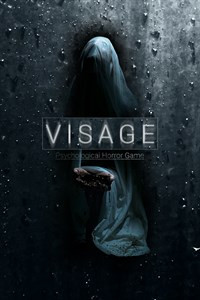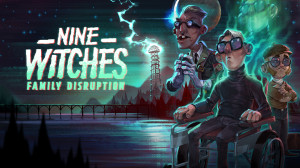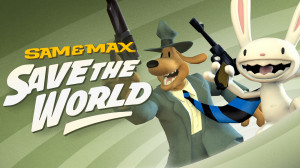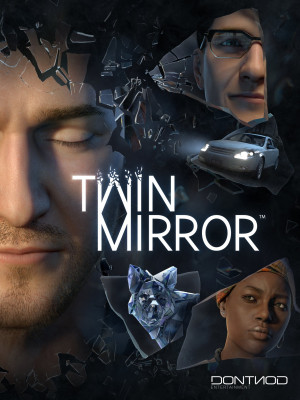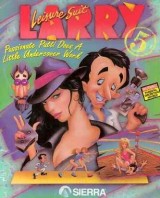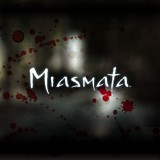Review for ENCODYA
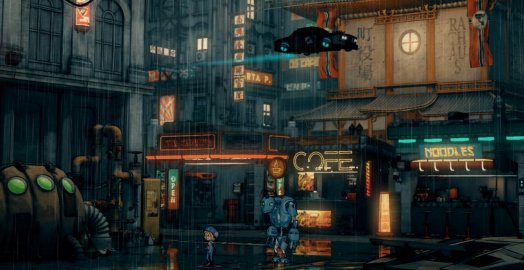
ENCODYA’s origins are quite unusual for a point-and-click adventure. The game revolves around characters from an eleven-minute animated film called “Robot Will Protect You” by the same Estonian creators (Chaosmonger Studio). The style of the movie is described by the developers as ‘toon cyberpunk’ and is itself a spin-off of a live-action short, “Attack of the Cyber Octopuses.” With multiple projects across different mediums, the next natural step was an interactive adventure, and while the transition isn’t entirely without a handful of vexing flaws that hold it back from being a masterpiece, Chaosmonger’s deep investment in this dystopian future universe really shows in the level of detail and heart put into the game.
The story begins on a rooftop with flying cars whizzing past in the distance and advertisements for gadgets and nightclubs floating by. The general chatter of Neo Berlin (circa 2062) – echoey announcements, the whoosh of the vehicles – can be heard faintly in the background. This dirty, massive metropolis is home to Tina, a nine-year-old orphan who scavenges to get by, and her guardian robot, the hulking but cute SAM-53.
Neo Berlin itself is a bleak place. Alongside the flashy hi-tech machines and vehicles, an addiction to virtual reality plagues many of the inhabitants. These poor souls stand in the streets, heads slumped forward as they stare into their VR sets, lost to the world. We’re told that the mayor uses this cyberspace world to control the population, keeping many of them too engaged in this simulation to question his shady practices. Thankfully for Tina, she hasn’t succumbed to the allure of this digital land.
It’s soon clear that the megalomaniac mayor and his goons are looking for our protagonist pair to retrieve a code that was locked inside SAM by Tina’s missing father years ago, intended to be unlocked by her when she reached ten. Unable to access the code due to her age, the search for clues takes our heroes beyond the expansive city, all the way to an alternate digital reality. Will they be able to solve the mystery before the mayor finds them? The story beats may be a little predictable in places, but the setup for this enjoyable romp was enough to pull me in.
The first section of ENCODYA, as you investigate your surroundings in Neo Berlin, are accompanied by ambient, slow-paced and calming tunes filled with reverberating synth chords, lightly tinkling keyboard notes and electronic bleeps and bloops. It helps to create a futuristic feel, although it did start to feel repetitive after a while, changing gradually but never really enough to distinguish between tracks. It does suddenly switch to a couple of epic pop ballads in the Italian diner, Renzo’s, where a singer (Maisy) floats on a cylindrical stage; it’s particularly striking given how different it is from the music previous to it. In the alternate world, the score takes on a more ethereal feel, peppered with chirps, suiting its forest setting nicely before later developing an urgent, tense beat as you hurtle towards the denouement.
All of the characters are fully voiced; the acting is convincing, and the sound quality high, with SAM and Tina sounding suitably robotic and child-like, respectively. The supporting characters are impressive too, with an audibly diverse range of deliveries. There are plenty of them to chat with as you explore the city, like the human-hating street sweeper with a Texan accent who’s simply called ‘nasty robot;’ or Esa and Aga, the red-haired twins who complete each other’s sentences; or Chef Hayao, a purveyor of German-Japanese fusion cuisine at a ramen shop (perhaps a nod to Hayao Miyazaki of Studio Ghibli fame). ENCODYA’s actually littered with pop culture mentions, which may have served as inspiration for this world – Beneath a Steel Sky and Hitchhiker's Guide to the Galaxy among them.
There are various dialogue options to choose from that will differ depending on whether you’re playing as SAM or Tina, whom you can switch between at will. It’s clear that SAM is protective of Tina, as you’d expect, although it would have been good to see that dynamic between them built up a little more. He’s also surprisingly opinionated about politics for a robot, at one point calling a city infographic ‘government propaganda’ and referring to the Cyberspace VR programme as ‘the opium of the people.’ Tina is similarly knowledgeable about the state of the city, frequently commenting how much she hates the mayor.
ENCODYA looks amazing, as you might expect given its background. The 3D models are creative and beautifully animated; little Tina is oddly proportioned, with a chunky face and a strangely oversized head, but SAM is pretty adorable as the large robot lumbering around, with messy cables protruding from his head, giant mechanical claws and comically asymmetrical glowing green eyes. In fact, most of the characters are well rendered and interesting, like the fortune-telling ‘fatemancer’ with her umbrella kept afloat with rotor blades, or the hulking, clunky and dumb guard-bot at Cybergaia Corp, where Tina’s father worked before he vanished. There are lots of nice touches; for example, if you hover your cursor over a hotspot, the character you’re controlling will turn their head to look at it. The occasional short cutscenes, which much like the rest of the game appear CGI-rendered but still retain a hand-drawn feel, all look fabulous.
The backgrounds are equally exceptional, showing the same attention to detail with a style that’s part cartoon, part realism and fully teeming with life. A variety of robots and human citizens go about their business as you explore: squat little three-legged machines awkwardly skitter about, bronze tin-pot contraptions waltz by, and purple levitating bots glide past. It certainly piqued my interest, wondering what was about to appear next; it’s just a shame you can’t interact with the quirky passersby. The overall aesthetic is both atmospheric and immersive, effectively portraying just what life is like in Neo Berlin: back alleys scattered with trash, walls covered in graffiti tags and art (including a rodent in a spacesuit), derelict cars blocking roads, the bright advertising bots slowly spinning overhead. The digital world you visit later in the game is a stark contrast to Neo Berlin; still gorgeous but filled with vibrant greens, flitting dragonflies and lush organic growth.
Unfortunately, in certain scenes there’s so much going on that it can be difficult to see what you can interact with. Some areas are presented from a top-down perspective, providing you with plenty of space to maneuver, while others are shown from the side and close up, meaning that the frequently passing cars flying past in the foreground obscure your view. SAM himself is large and follows Tina automatically (when you’re in control of her), so he often gets in the way. Of course, you can always switch to SAM and move him, but it can get somewhat irritating.
Most of the controls are fairly standard for a point-and-click adventure: left-click to move your character anywhere on the screen; switch between protagonists (Tina or SAM) by selecting their portraits at the top left; click on the icon at the bottom right to make your inventory pop up next to it. With the inventory open your items can either be examined in more detail or combined with each other or with certain interactive spots around you by selecting the use icon. One slight annoyance is that once you’ve unsuccessfully attempted to use an object with something else, it’s automatically deselected afterwards, so if you want to try out an item with a number of different things in the scene, you’ll have to go through the whole process every time.
Interacting with something in the background will bring up one or more context-relevant verb icons to choose from. These include a magnifying glass to look, a hand to take, a mouth to talk, and a hand clasping a spanner to use or grasping a rope to pull. At least, those are the images if you’re playing as Tina; if you’re controlling SAM, the symbols will be more robot-appropriate, like a telephone to talk or a robot arm to pick something up. It’s a great little detail and really illustrates how much love was clearly poured into the presentation. Each character will have different comments to make about things as you explore, so it’s worth swapping between the two occasionally just to hear their own take on the world that surrounds you. It’s a requirement to progress in several puzzles, anyway; Tina’s tiny hands will fit in small places, and SAM is the only one who can interpret certain languages (including binary).
Arrows and location information at the edge of the frame let you know when you can travel to a different area. You can double-click to move there immediately, which is handy since SAM is pretty slow as he robotically lurches around (Tina isn’t exactly speedy herself). Double-clicking within a scene will spur your character into a run. Unfortunately, if you’re attempting to look at a hotspot, the character will very slowly plod there first; it’d be better to have an ‘always run’ option. There’s a map function, too, which allows you to jump to another location in the city, reducing needless backtracking. Though most of the experience takes place on the streets of Neo Berlin and in the beautiful digital forest, your quest will occasionally divert you to dilapidated tower blocks, local businesses, and even a rusting ship.
An exclamation mark at the top right provides access to your current mission list, reminding you of your objectives. These seem quite simple to begin with – get some robot oil for SAM, find food, locate a pair of socks – but eventually progress to more ambitious-sounding goals like cheating your way past a bioscanner and finding Tina’s dad’s secret lab. Most require a chain of tasks to be completed before they can be ticked off the list. Above the ‘!’ is a cog, where you’ll find the usual menu for saving (the game also autosaves, but you have three slots you can choose to manually save in), loading, options and a reminder about the controls. You can also see here what percentage of the game you’ve completed and how many of the ten secrets you’ve found. These secrets are optional and can be hard to track down, but are genuinely worth finding (although you’ll have to trust me on that, as I’m not about to spoil the surprises).
Two game difficulties are available, easy and hard, with two key differences between them. If you’ve selected the former, you’ll be able to access hints and use the space bar to (dimly) highlight collectible items – but not all interactive hotspots, so you’ll still need to thoroughly explore each scene as it can be easy to miss things, particularly since many of them are quite small. This just feels like an unnecessary annoyance and renders the space bar function pretty useless – why not just highlight everything you can inspect? The clues, which you can ask for by talking to SAM, I often didn’t find to be all that helpful, mainly confirming what I already knew along with generic tips such as ‘talk to everyone.’ In hard mode, you’re on your own, with neither hints nor highlights, which you may not find all that much harder.
I certainly would have found more explicit hints useful at times. At one point I found myself completely stuck and referring to a walkthrough, only to discover that I was missing an item needed to progress because SAM had been standing over it when I was scouring a scene. Later, when trying to get video footage from a monitoring drone, I felt like arriving at a solution by myself would have required some serious mental gymnastics. Thankfully, not all obstacles are this tricky to overcome. Most of the puzzles require use of the inventory, though sometimes with a more interesting twist – one involved defacing political posters around the city, and another required using a gadget to track down hidden words in the area. Depending on how stuck you get, it should take around 7-8 hours or more to complete the game.
Although the pixel hunting and the obscurity of a handful of puzzles are occasionally irritating, overall ENCODYA is far more fun than it is frustrating. I can’t pretend that I’m not disappointed about the lack of cyber octopuses, but there are so many beautiful places to explore, just soaking up the scenery and immersing yourself in this intriguing dystopian world to the accompaniment of such a fitting soundtrack is well worth the visit to Neo Berlin.
Complimentary review copy generously provided by GOG.com.


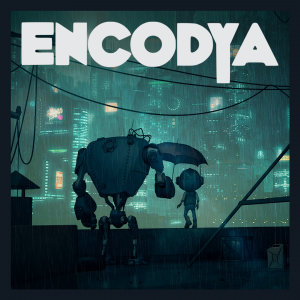



__large.jpg)




